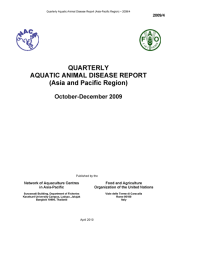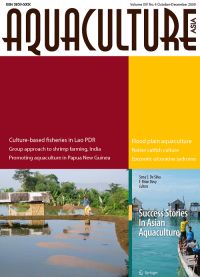This report, the 46th in the series, contains information about the aquatic animal health status of sixteen states in the Asia-Pacific region. The foreword discusses important emerging diseases in the region and the outcomes of the 8th meeting of the Asia Regional Advisory Group on Aquatic Animal Health.
In this issue:
Mussel farming initiatives in North Kerala, India. Selective study on availability of indigenous fish with ornamental value in West Bengal. Aquaculture livelihoods centre in Aceh, Indonesia. e-Sagu Aqua - an innovative information and communication technology model for transfer of technology for aquaculture. Freshwater pearl crop: An emerging enterprise in the Indian subcontinent. Preliminary risk assessment of Pacific white shrimp (P. vannamei) introduced to Thailand for aquaculture. Black gill disease of lobster and more.
In this issue:
Success Stories in Asian Aquaculture. Twelfth Regular Session of Commission on Genetic Resources for Food and Agriculture. Training of trainers programme will strengthen small scale farmer competitiveness in ASEAN. Workshop on development of better management practices for catfish farming in the Mekong Delta organised in Vietnam. Vulnerability & adaption of climate change impacts on catfish farming - case study Can Tho, Vietnam. NACA welcomes Dr Nigel Abery, Coordinator of the Adaption of aquaculture to climate change project. EU supports better management practices for responsible aquaculture. Myanmar delegation visits CIFA to study aquaculture.
Fish species introduction has been a very important method of increasing fisheries production and economic output in China. A good example is the introduction of the icefish Neosalanx taihuensis into reservoirs and lakes in most areas of China. The present study aims to provide basic information on production, management strategies and biological characteristics in target reservoirs and lakes in China and guide introduction and management practices of the fish.
This brief reports on a catfish farming stakeholder workshop and focus group meeting on vulnerability and adaption to climate change held in Can Tho, Vietnam. Stakeholders including catfish farmers in general expressed that climate change is a serious threat, having observed shifts in climatic patterns, saline water intrusion and frequent typhoons. Suggestions to reduce on-farm risks included producing quality fry, developing new culture systems, elevating dykes, livelihood diversification, awareness workshops and financial support to farmers.




